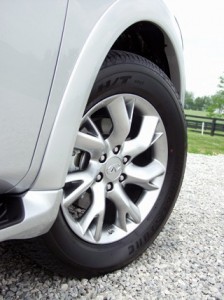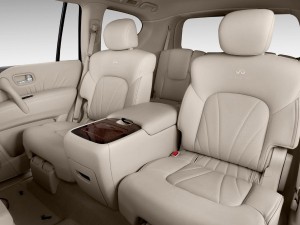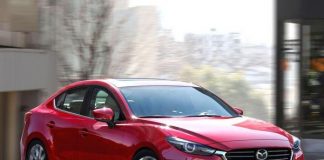The Hummer may be history but there are still ways to stick your finger in the eye of political correctness. 
For instance, you could buy a new Infiniti Q56.
It is Elvis in full rhinestone flower, circa ’74 and the Live From Hawaii special. A no-holds-barred, joltin’ juggernaut of pearlescent clear-coated gaudiness. A 14 MPG, $62,000 spectacle of unashamed consumption – 22 inch wheels spitting rooster tails of sod across Al Gore’s lawn.
If you hate him and all he stands for, you will love the Q56.
And, of course, the reverse.
WHAT IT IS
The Q56 is six thousand pounds of full-size, three-row, real-deal 4WD SUV – with all the proverbial bells and whistles.
Base price is $59,200 for the 2WD version; the 4WD equipped model starts at $62,300.
With options such as the$4,500 Touring Package, the $2,950 Theater Package and the $2,300 22 inch wheel/tire package, a new Q can easily sail past $70k out the door.
Competitors include the also three-row – but physically smaller – Lexus LX570 and the similarly sizable and ostentatious – but more street-minded (because it’s AWD, not 4WD) Cadillac Escalade.
You might also cross-shop the Lincoln Navigator. It has three rows – and is available with real 4WD. It’s also pretty cheap relative to all these, at just $57,775 to start. Loaded with 4WD, it’s under $63k. But the current Navigator’s pretty long in the tooth – it’s pretty much the same today as it was back in ’09 – and Lincoln itself has deteriorated into something less than a top-tier nameplate.
Still, it’s probably worth a look.
WHAT’S NEW
The Q was completely overhauled in 2011 for the 2012 model year, so the ’13 is more or less the same as last year – with the exception of a few mention-worthy updates such as Moving Object Detection for the closed circuit exterior camera system and standard auto-dimming exterior mirrors.
WHAT’S GOOD
Mid sixes to 60, despite 6,000 lbs. at the curb.
Real 4WD with Low range and two-speed transfer case. Goes where the AWD-only Caddy can’t.
Beautiful on the inside.
A steal on wheels relative to the $80,930-to-start Lexus LX570.
Sucks gas like a ’68 Polara 440 – with 500 pounds of cement in the trunk.
Not-so-beautiful on the outside.
Weak seat heaters. Warmers, really.
UNDER THE HOOD
The Q has what you need to get six thousand lbs. of metal moving – a 5.6 liter, 400 hp V-8 that also makes 413 lbs.-ft. of torque. Some modern V-8s produce tremendous hp, but are so-so on torque output, in part because they’re on the small side – relative to the V-8s of the past. The Q’s V-8 is decent-sized, so it makes both lots of hp – and plenty of torque – which is what you need to get something as hefty as this thing going in a hurry.
A seven speed automatic with rev-matching downshifts (as in the Nissan 370Z sports car) is standard. You can go RWD – and tire-frying burnouts – or 4WD. Real 4WD, with a two-speed transfer case and Low range gearing, controlled by a rotary knob on the center console. The transmission also has Snow and Tow modes, controlled by buttons adjacent to the rotary knob controller for the 4WD.
The RWD version can get to 60 in 6.7 seconds or so; the heavier 4WD version still makes the cut under 7.
This is a fierce run for a beast this big – and this heavy. It’s also pick of the litter: quicker than the less powerful (383 hp) Lexus LX570, which does the zero to 60 run in about 7.5 seconds – and also – interestingly – the slightly more powerful (403 hp) Caddy Escalade, which also needs about 7.5 seconds to reach 60. 
The Q flat-out creams the poor Lincoln Navigator, too. Clocking in at 8.4 seconds to 60, the aging Navigator is easy meat.
Of course, you’ll pay – at the pump – to savor the flavor of the Q’s physics-defying performance: 14 city, 20 highway – and that’s just what the EPA says. Here’s what the Qs trip computer said after my week-long test drive: 11.5 MPG, average. The big eight likes to drink premium, too. So, filling the 26 gallon tank will cost you about $100 at current prices – and you’ll be filling it often.
To be fair, the same is true of the others in this class.
The Escalade’s slightly worse, actually: 14 city, 18 highway according to the EPA. Ditto the Lexus: 12 city, 18 highway. And remember, it’s slower.
Both of them are.
Max tow capability is 8,500 lbs. – a bit more than the Caddy (8,300 lb.s) and a lot more than the LX570 (7,000 lbs.)
Interestingly, the Navigator wins this one. It can pull up to 9,000 lbs.
ON THE ROAD
Where’s the beef?
It’s there – for sure – but mostly, you don’t notice it.
This is the most obvious difference, driving-wise, between the Q and other super-sized SUVs. The Q is actually plausibly sporty: It not only accelerates more swiftly than most cars (the rev-matching downshifts of the seven-speed automatic adds to the ambiance of athleticism) it also takes curves at speed without tripping all over itself – something few SUVs, even after all these years of civilizing them, can do. 
You can lean on the Q – and it doesn’t.
Part of the reason for this is Infiniti’s Hydraulic Body Motion Control – an option the Q56 I tested had (it’s part of the Touring Package, which is also includes the 22 inch wheel/tire package). It tamps down body roll during cornering by pumping up the suspension on the outside of the corner you’re entering to compensate for the lateral forces on all that high-riding bulk – which would otherwise want to heave toward the outside of the corner.
The system really works – and more, it works with subtlety. In other SUVs, handling deficits are dealt with reactively, by the sudden intervention of the stability/traction control system. You feel brakes pumping, throttle being dialed back. The frantic little yellow TCS light flashes alarmingly in the gauge cluster. In the Q, you just drive on. You have to be really pouring the coals to it for the stability control to come on.
This makes for a more pleasant – a more confidence-inspiring – driving experience.
The 22 inch wheels and short sidewall performance tires (also available as a stand-alone option for $2,300) surely help the handling but surprisingly, don’t kill the ride quality. This is most definitely not par for the course. I have driven many new vehicles with 20-plus-inch wheels and almost all of them ride like leaf-sprung, solid-axle Willys Jeeps. 
But not the Q.
The 22 inch tires do have some downsides, though. I checked Tire Rack and found that the standard 20 inch tires (OE replacement) cost $220 each. The 22 inch tires surely cost more and because they’re performance-minded (compound as well as short sidewall) they probably won’t last 20,000 miles before they need to be replaced.
Another thing to bear in mind is these meats are not the hot ticket for off-road duty. It’s a compromise to be aware of if you need your Q to deal with other-than-paved situations. Good tires matter as much as a good 4WD system. Or more accurately stated, a good 4WD system is only as good as the tires it’s working through.
That said, this is one of the relatively few really big SUVs left that can still be taken off-road – assuming you’ve got the right tires for that. The availability of real 4WD – vs. the car-esque AWD in the Escalade – should be a draw for buyers who need to a deep snow (and mud) capable vehicle.
I am not a fan of the optional blind-spot/lane departure warning system. During my test drive, it would frequently false trigger – with attendant (and annoying) audible warning – just driving along (all by myself) on windy country roads. Trees too close to the road would do it – fooling the proximity sensors into thinking a car was in the blind spot. Luckily, it can be turned off.
Unluckily, you have to turn it off every time you start the Q.
Just a minor annoyance.
Likewise, the slightly audible dieseling sound coming from the direct-injected engine. They all do this, by the way – not just the Q, not just Infinitis. Anything with DI. But you can’t hear it with windows up and doors closed. It’s only noticeable when you’re standing outside the running vehicle. And it’s a small annoyance worth putting up with, too – because without DI, the Q’s gas mileage would probably by around 9 MPG, average, instead of 11-ish.
I love that the Q – like all Infinitis (and all Nissans) does not beep at you if you haven’t “buckled up for safety.”
Just a little red light on the dash, that’s it.
Looks are, as the saying goes, in the eye of the beholder. To me, the Q is a bit on the bulbous and Sloth (from The Goonies) looking on the outside. Some incongruous styling affectations, such as the side vents on the front fenders, seem out of place. I guess they felt they needed to do something to break up all the acres of sheetmetal… .
But the main thing – the desirable thing for a vehicle of this type – is the Footprint, physical as well as psychological. Size is accentuated not toned down. Everything from the 22 inch wheels up seems deliberately intended to convey massiveness without apology. You will be noticed.
And feared.
Imagine being the driver of a not-so-SmartCar and finding yourself suddenly in the looming shadow of a Q. You’ll want to move to the side, like a dinghy in the wake of Titanic. And that’s part of the politically incorrect fun of owning something like the Q: To be large – and in charge.
And the Q is very large.
About seventeen and a half feet (208.3 inches) stem to stern – about a foot longer than the Lexus LX570 (196.5 inches). Even the standard-bearing ship-of-the-line, the Cadillac Escalade, only tapes out at 202.5 inches (though Caddy does offer an extended version of the Escalade, the ESV, that runs to 222.9 inches). 
Still, it’s hard to get bigger. Which brings up an important point:
In newer houses – meaning, built since the 1980s – it’s a good idea to measure the length (and width and height) of your garage before you buy a vehicle like this.
All the vehicles in this general category have enough interior space for the Brady Bunch. However, the Q can seat as many as eight people, which is one more than than the usual seven. Access to the back seat area is made easier by such things as an available automatic second-row tilt/fold controlled by the driver via a pair of buttons on the front console. This is in addition to the automatic fold-stow for the third row, controlled by switches in the tailgate area.
Cargo capacity with all seats up is 16.6 cubes, slightly more than the Lexus LX (15.5 cubes) and dead heat with the Caddy Escalade (16.9 cubic feet).
The interior layout itself is like the Emperor’s Suit at Trump Towers – or something along those lines. You are greeted by etched mesh background gauges, the numerals backlit and hidden until you push the ignition button – at which point they come alive with an electro-phosphorescent glow.
Every panel is soft-touch, accented by chrome here, wood inlays there. The only problem with it is that it’s way too nice to even think about setting a muddy boot on the plush carpets or a gloved and grimy hand on the hand-stitched leather steering wheel. 
You can order a rearseat entertainment system with individual LCD monitors built into the headrests, the nav system is voice-command and there’s a really neat perimeter camera system that not only shows you what’s behind you but also what’s to the sides of you – all at the same time.
The 15 speaker Bose stereo that comes with the Deluxe Touring Package is just incredible.
THE REST
The seat heaters are at best, warmers. They definitely don’t get hot – and (trust me) you can get hot seat heaters in vehicles that cost a third what the Q costs. I test-drove the Q in late Fall, when it was only chilly outside (high 50s at night). When it’s cold outside, you’re going to want more BTUs. Ditto the heated steering wheel that is packaged with the seats. It’s noticeable, but “heated” is generous.
They really need to wick it up.
It’s s small issue, overall – but at $75,340 (the MSRP of the fully laden Q I tested) the seats ought to do more than just warm slightly.
The only other real-deal 4WD SUVs that can be said to handle – the Porsche Cayenne and the Range Rover Sport – are either a lot more expensive or considerably smaller, with room for only five in two rows instead of eight in three. The Navigator has size – but it’s slow – and old.
For genuine sportiness – with real capability – and without-compromise luxury – and size, too – it’s hard to beat the Q.
Throw it in the Woods?













i think it is atrocious looking but would definately take it over an H2 or H3 hummer.
i wonder when the one with bullet proof door panels and glass are coming out for the “Import/Export” entrepenuer.
If I wanted/needed and Could Afford “that type of vehicle,” this is the one I’d get, for sure.
Now that is one ugly looking SOB.
Ken.
Ha!
Did you like the Goonies reference?